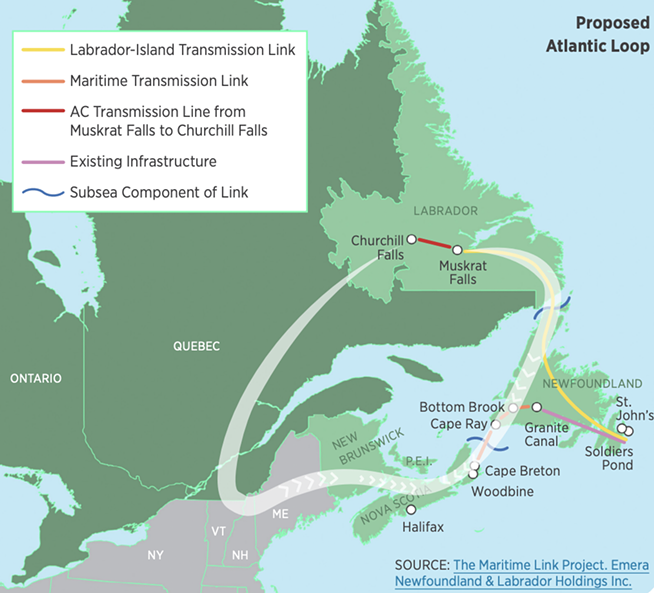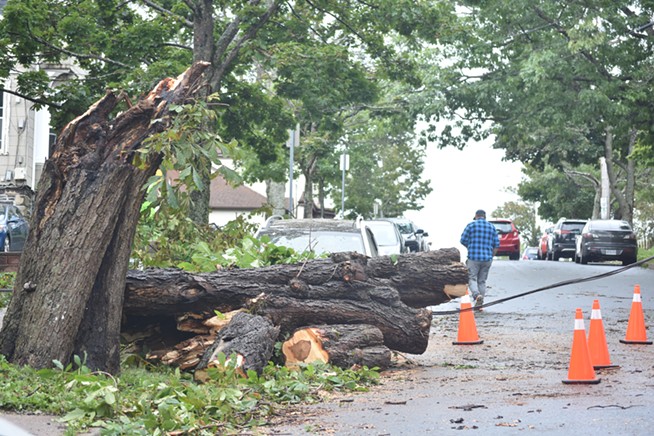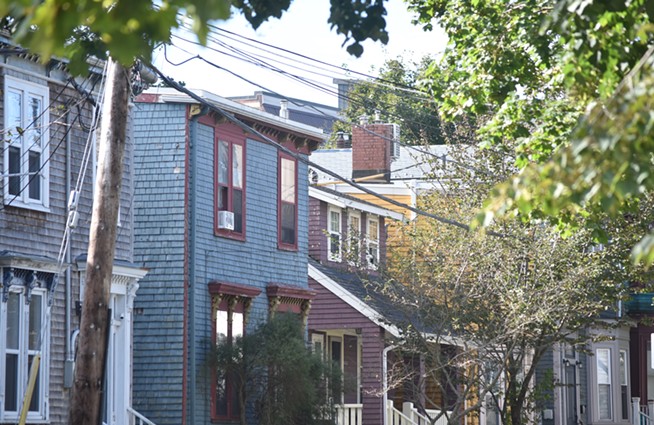Amid the dizzying displays of oil wealth and lofty visions of AI’s potential to save the planet at the United Nations-led global climate summit (COP28) happening now in Dubai, one neon-emblazoned sign stood out for its brutal honesty: “Act as if your house is on fire,” the conference pavilion display read, “because it is.” The words—co-opted from Swedish climate activist Greta Thunberg’s famed speech to world leaders in Davos in 2019—have felt closer to home in Nova Scotia as of late. This year, we witnessed the province’s most devastating wildfire season on record: More than 25,000 hectares of land burned from Shelburne to Upper Tantallon. Two-hundred families lost their homes. Thousands more were forced to flee without knowing when—or if—they would be cleared to return.
Premier Tim Houston called Nova Scotia a “changed province” in the wildfires’ aftermath, adding that both the emotional and financial scars would “run deep” and take time to heal.
But as the province’s recovery time extends into years, another time window shrinks: The opportunity to act as Earth accelerates toward 1.5 degrees Celsius of warming from pre-industrial levels. Keeping under that threshold, most climate scientists agree, would shield us from the most brutal of climate futures. Beyond that limit, we invite catastrophe. More homes lost to floods. Crops and other species—whole ecosystems—would die. Global famines could spark. Thawing permafrost could reintroduce waves of infectious diseases.
The European Union’s climate-monitoring service, Copernicus, has already declared 2023 the hottest year on record. Between January and November, global average temperatures reached 1.46C above pre-industrial levels—and for the first time in recorded history, on Nov. 17 and 18, the Earth’s temperature briefly exceeded the two-degree threshold. That it happened on the eve of COP28 should send a “very clear message,” Copernicus director Carlo Buontempo said in a statement. “The time for definitive action to tackle climate change is now.”
Nova Scotia—and much of Canada, for that matter—has followed a slightly different timeline: The province has targeted 2030 to phase out coal and reach an 80% renewable-energy power grid. Houston’s governing PC Party sees wind and solar as the key to meet those goals.
But is the province’s plan ambitious enough?
Farewell, Atlantic Loop
Like COP28’s host nation, Nova Scotia is among the world’s laggards when it comes to clean energy. (Though next to oil-rich Dubai, it might look shinier.) As of today, less than a quarter of our province’s power supply comes from wind, hydro, tidal and solar. (Only Alberta, Saskatchewan and Nunavut—which gets almost all of its energy from burning diesel—have lower scores for renewable power among Canada’s provinces and territories.) By contrast, Newfoundland and Labrador, PEI, Quebec, Manitoba, British Columbia and the Yukon each generate over 93% of their electricity from renewables.
Some of that divide can be explained by geography: BC, Quebec and the Yukon have towering mountain ranges and powerful river systems to harness. (A quarter of BC’s power comes from three dams on the Columbia River alone.) Manitoba has more than 100,000 lakes. Ontario has Niagara Falls.
Nova Scotia has had hydroelectric power “for decades,” says David Miller, director of Nova Scotia’s electricity policy and programs. Even so, hydro accounts for a mere eight percent of the province’s power supply—and it’s not likely to grow. That’s because “basically every river that could reasonably be dammed was dammed,” Miller told The Coast in June.
“We don’t have the elevation change or the big rivers that you get in Ontario, BC or Quebec. So wind was the other obvious solution—or tidal. And wind was much more commercially available.”
“We don’t have the elevation change or the big rivers that you get in Ontario, BC or Quebec. So wind was the other obvious solution—or tidal. And wind was much more commercially available.”
tweet this
The federal government had hoped that Nova Scotia would meet its energy targets by committing to a so-called Atlantic Loop: A “high-capacity” transmission system that would deliver renewable energy from Hydro-Québec to New Brunswick and Nova Scotia while the provinces revamped their power grids. Then, one day, it would bring clean energy from Atlantic Canada back to Quebec and onward to markets in Ontario and the northeastern US.
But—as with almost all things these days—the cost has proven difficult to stomach. Nova Scotia’s government says it would cost $9 billion in infrastructure upgrades to bring power from Quebec into the province—a threefold increase in projected costs from 2020. Premier Houston told reporters in June that the Atlantic Loop had the “potential to bankrupt our province.”
That runs counter to what the federal Liberals have said. That same month, Central Nova MP Sean Fraser told reporters that his government saw the Loop as the “least costly option for households” as Nova Scotia weans itself off coal and oil.
“If there are alternative proposals that are [less] costly, of course we’re interested in hearing what they may be," he added. “But to date, by far the least-costly option that anyone has identified with something more than back-of-napkin math is the Atlantic Loop.”

In October, Nova Scotia’s natural resources and renewables minister Tory Rushton announced the province had made changes to its Electricity Act that would allow it to “quickly approve innovative energy storage projects” that would help “advance the use of batteries for storing excess renewable energy” and “exceed” the province’s goal of 80% renewable energy by 2030. On Dec. 1, Rushton followed that by announcing a “Green Choice Program” that would give large-scale customers—think companies like Michelin, or universities like Dalhousie—the option to source 100% of their power from renewables. The province expects the program could add 10% more renewable energy to the grid by 2027-28.
Nova Scotia’s government is bullish that it can, in fact, surpass its 80% target and end up closer to 88% by 2030. And that’s largely because of one reason, Miller says.
“Over the last four years that I’ve been in this role, renewables have gone from a premium product to the cheapest product,” he told The Coast in June. “And the issue isn’t, ‘Well, how many should we buy that are cost-effective?’ It’s ‘How many can we buy and work inside our system?’”
“Where we’re at today, renewables are the cheapest resource available for energy generation in Nova Scotia.”
tweet this
Even with cheaper costs converting the PC Party of Nova Scotia into clean energy boosters, there are other hurdles to overcome. For one thing, the province is growing—and Nova Scotia’s government has aggressive goals to double its population to two million by 2060. That puts additional strain on the power grid. (“The more energy we consume, the harder it is to decarbonize,” Miller says.) Then, there’s the matter of consistent supply—and that might be the thorniest bit. Solar power works great, Miller says, until the sun sets or the clouds arrive. Ditto for wind power until the gales go away. And that doesn’t work for systems that require steady power—like hospitals, for instance.
“The solution for Nova Scotia, in all futures, includes more wind, more solar, probably batteries and probably some investment in gas. And I think that’s going to be hard for people to understand how building fossil resources enables decarbonization.
“But the electricity system has to function—it is a matter of life or death for people, frankly… You can’t leave people in the cold in February.”
Nova Scotia’s power problem
Some argue there’s a barrier to Nova Scotia meeting its energy goals that isn’t being touched. It boils down to ownership: The province doesn’t own its power supply, nor the network of cables and towers that connects homes from Yarmouth to Sydney—Emera does. And thanks to an agreement set by the province, it’s guaranteed an annual profit margin between 8.75% and 9.25%—never mind if thousands of Nova Scotians seem to lose power with each winter storm or heavy rainfall. Last year, Emera raked in $46 million in adjusted net income from owning Nova Scotia Power, per the company’s end-of-year financial disclosures.

Nova Scotia NDP leader Claudia Chender wonders why the provincial government doesn’t rewrite the agreement. In March 2022, she introduced a private member’s bill to direct the province to study the “advantages and disadvantages” of bringing Nova Scotia Power—either in whole or in part—back under public ownership.
“This government came to power telling people that they were going to do their homework, and that all options were on the table,” Chender told The Coast in February. “And so one of our responses to that was to say, ‘Great, here’s some homework. Let’s understand the ownership structure of our utility, what it is and what it could be, and how it would best serve Nova Scotians.’”
She believes there are “lots of reasons” why Nova Scotia might want to reassume control of its power grid—“particularly when it comes to adding more renewable energy to that grid and having an open competition for where that renewable energy comes from. Because right now, Nova Scotia Power really holds the keys to that kingdom.”

Chender isn’t alone in thinking there’s merit to the discussion. For more than a decade, policy analyst Christopher Majka has argued that the province should re-expropriate Nova Scotia Power’s network of cables and towers. (In 1972, under premier Gerald Regan, the provincial government bought out 90% of the former Nova Scotia Light and Power’s stock. The province owned the utility until 1992, when premier Donald Cameron’s cash-strapped government sold it off for $192 million—worth $361 million today.)
Majka believes that Cameron’s government dropped the ball.
“[Nova Scotia Power] was sold to the private sector for no sound economic reason,” he told The Coast in February. The province, Majka notes, had billed the sale as a capital gain that would help to balance its books. Instead, it turned out to be a loss: The utility should have sold for $300 million in 1992—worth $564 million today.
Majka would like to see Nova Scotia reclaim control of its power network, if not the coal plants themselves. “To a large extent, those assets are rapidly diminishing in value, so there isn’t really any advantage for Nova Scotians to purchase those,” he says. Owning the network of cables across the province, on the other hand, opens up a realm of opportunities.
“[Nova Scotia Power] was sold to the private sector for no sound economic reason.”
tweet this
“They would allow us to make all kinds of decisions with respect to investments and also control what we do with those and how we develop them and make them better. And that would be done entirely on the basis of public interest, rather than private profit,” he told The Coast in February.
Case in point: Burying power lines underground. For Nova Scotia Power, the higher cost of putting lines underground doesn’t make sense when it comes to serving its shareholders, who want to see the highest rate of returns. But it makes a whole lot more sense in a province that wants to improve its power stability during fall and winter storms.
“We know from climate change that these events which we’ve experienced recently are certainly going to continue, and they’re certainly going to get more severe,” Majka argues. “And as much as we need to try and stop climate change, the horse is out of the barn… and we now also have to be thinking seriously about remediation.”

As convinced as Miller is about renewable energy’s future, the electricity policy and programs director has his doubts that expropriating Nova Scotia’s power grid would bring about swifter change.
“If Nova Scotia Power was a Crown [corporation], would they be substantially different? Maybe, but I’m not convinced that is actually the driver or the constraint on decarbonization,” he told The Coast. “I think that New Brunswick Power has behaved very similarly. I think utilities behave like utilities, generally, whether they’re publicly or privately held: They were not designed to rapidly change; they were designed to incrementally kind of move forward along a pathway.”
But there are other barriers that a privately-owned Nova Scotia Power poses to the government’s clean energy aims, Majka argues. Take, for instance, Nova Scotia Power’s influence on small-scale renewable energy producers. In January 2022, the utility company applied before the Utility and Review Board for a monthly fee for homeowners who sell power back to the grid—a move that drew sharp criticism from solar installers who said it would hamstring the growing industry.
“It will directly impact people’s decision to go solar. They basically won’t do it,” Renewly Solar Inc. owner Yohan Peiris told CTV News.

Houston’s government fixed that in April 2022 when it barred NSP from imposing fees on homeowners and businesses who install solar panels or wind turbines. But as the Halifax Examiner has reported, the provincial legislation still defers to NSP when it doesn’t need to: For one thing, advocates warn the province’s aims to help low-income families with their power bills accomplishes little without further amendments to the Public Utility Act.
Chender proposed such an amendment in a separate private member’s bill, also introduced in March 2022. It went into second reading last November. (Timberlea-Prospect MLA Iain Rankin supported the bill, calling it a “positive thing to broaden a mandate for the Utility and Review Board,” and saying it would “move the needle towards the public interests.” The bill faced stiffer opposition from the governing PC Party, whose MLA Kent Smith, representing Eastern Shore, said, “We’re not going to advance this piece of legislation in the exact way that the Opposition would prefer, but we have taken a multitude of steps to lower individuals’ power bills.”)
Chender has been diplomatic in her response to how her bills have been received.
“We’re still hoping that the government makes good on their promise of doing their homework,” she told The Coast in February.
“I really believe that people want power that is affordable, reliable and green,” she added. “And right now, we’re not really getting any of those.”
How much would it cost to re-publicize Nova Scotia’s power grid?
Majka is used to the reservations he hears when he talks about buying back Nova Scotia’s power network. There’s the usual kicker: How much would it cost? Surely, too much.
“Time and again, the objection has been we can’t afford it,” Majka tells The Coast. “We absolutely can.”

His answer: Issue government bonds. Instead of funding the purchase of Nova Scotia Power—in whole or in part—through its own coffers (i.e. taxes), the province could issue bonds to match the price tag. Those bonds would then come with a guaranteed rate of return over two years, or three years, or longer. (Any rate of return lower than 8% would “still be significantly less than the 9% profit margins of Nova Scotia Power,” Majka says.) Bondholders, in turn, would fund the utility’s purchase.
It’s a win-win, Majka believes: Taxpayers are off the hook for the project, the government takes back control of its power grid and bondholders get a decent return, to boot. Any excess revenue flows back into improving the province’s power grid, instead of going to private shareholders.
“Governments have that power to expropriate,” he says. “We could do it. All it requires is political will.”
“Governments have that power to expropriate… We could do it. All it requires is political will.”
tweet this
In both February and December, The Coast reached out to Nova Scotia’s natural resources and renewables minister Tory Rushton’s office for comment on what options, if any, the province is exploring with respect to buying back part or all of NSP. Minister Rushton has not been made available for an interview.
In an emailed statement to The Coast, however, a provincial spokesperson says re-publicizing Nova Scotia Power is “not something we’re considering at the moment,” and that instead, the government is “strengthening performance standards for NSP” and “holding the utility more accountable for things like reliability.” (In 2020, CBC reporters tracked power outages “nearly every day of the year” in Nova Scotia, only missing two days. Nova Scotia Power had unplanned outages “every day,” they found. As of this writing—on a clear-skied Thursday—there are eight active outages across the province.)
For his part, Majka continues to rally against what he describes as “austerity politics” affecting Nova Scotia’s quality of living.
“Small government, little spending and privatization of public resources… you can get away with that for a certain amount of time,” he says, “but eventually it sort of catches up with you when the infrastructure starts to crumble.”




















